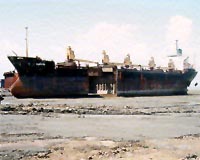| . |  |
. |
Washington DC (SPX) Aug 26, 2010 A new simulation of oil and methane leaked into the Gulf of Mexico suggests that deep hypoxic zones or "dead zones" could form near the source of the pollution. The research investigates five scenarios of oil and methane plumes at different depths and incorporates an estimated rate of flow from the Deepwater Horizon spill, which released oil and methane gas into the Gulf from April to mid July of this year. A scientific paper on the research has been accepted for publication by Geophysical Research Letters, a journal of the American Geophysical Union, Scientists at the National Oceanic and Atmospheric Administration (NOAA) and Princeton University conducted the research. Based on their simulations, they conclude that the ocean hypoxia or toxic concentrations of dissolved oil arising from the Deepwater Horizon blowout are likely to be "locally significant but regionally confined to the northern Gulf of Mexico." A hypoxic or "dead" zone is a region of ocean where oxygen levels have dropped too low to support most forms of life, typically because microbes consuming a glut of nutrients in the water use up the local oxygen as they consume the material. "According to our simulations, these hypoxic areas will be peaking in October," says study coauthor Robert Hallberg of the NOAA Geophysical Fluid Dynamics Laboratory in Princeton, N.J.. "Oxygen drawdown will go away slowly, as the tainted water is mixed with Gulf waters that weren't affected. We're estimating a couple of years" before the dead zone has dissipated, he adds. Although the Princeton-NOAA study was carried out when the flow rate from the Deepwater Horizon spill was still underestimated, the simulated leak lasted longer than did the actual spill. Consequently, says Alistair Adcroft of Princeton University and the NOAA Geophysical Fluid Dynamics Laboratory, another study coauthor, "the overall impact on oxygen turns out to be about the same" as would be expected from the Deepwater Horizon spill.
Share This Article With Planet Earth
Related Links American Geophysical Union Our Polluted World and Cleaning It Up
 Bangladesh top court bans 'toxic' ships
Bangladesh top court bans 'toxic' shipsDhaka (AFP) Aug 23, 2010 Bangladesh's Supreme Court has reimposed strict environmental controls on the country's ship-breaking yards, a lawyer said Monday, in a verdict likely to trigger protests from the sector. Companies warned that the decision could be disastrous for the country's ship-breaking industry, the world's largest. All ships scrapped must now be certified toxic-free by the selling nation's environm ... read more |
|
| The content herein, unless otherwise known to be public domain, are Copyright 1995-2010 - SpaceDaily. AFP and UPI Wire Stories are copyright Agence France-Presse and United Press International. ESA Portal Reports are copyright European Space Agency. All NASA sourced material is public domain. Additional copyrights may apply in whole or part to other bona fide parties. Advertising does not imply endorsement,agreement or approval of any opinions, statements or information provided by SpaceDaily on any Web page published or hosted by SpaceDaily. Privacy Statement |